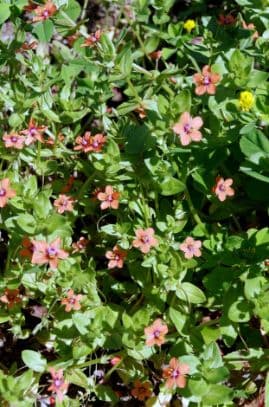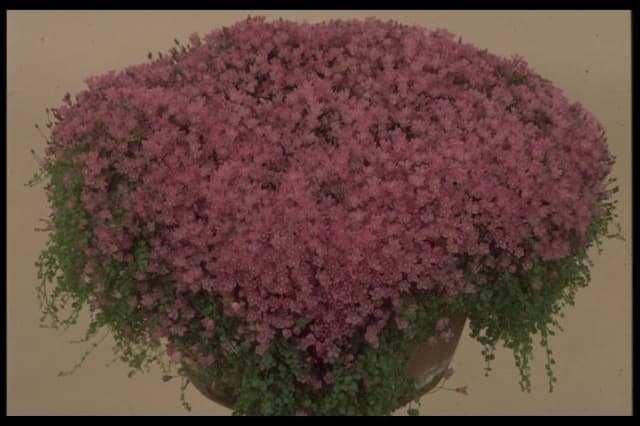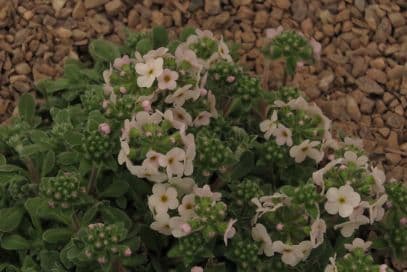Primrose Primula 'Theodora' (Pr)

ABOUT
Primula 'Theodora', commonly known as primrose, is a charming flowering plant that boasts a lush mound of foliage from which stems arise, bearing clusters of delicate flowers. The leaves of the primrose are typically bright green, forming a rosette at the base, and possess a texture that can range from smooth to gently crinkled. The leaf edges may be softly toothed, giving them a slightly ruffled appearance that adds texture to the plant's overall look. The flowers of Primula 'Theodora' arise on slender stalks and present a cheerful display that can catch the eye from a distance. Each flower consists of five rounded petals that come together to form a shallow cup shape. These blooms exhibit a rich array of colors that often include various shades of pink, red, purple, yellow, or white. The center of the flowers usually features a contrasting hue, adding to their visual appeal. A characteristic of the primrose is its bright, prominent eye, which often shines with a golden or yellow tone, creating a striking focal point for each flower head. Beyond its colorful blossoms, the primrose is appreciated for its extended blooming period, often bringing color and life to the garden when many other plants have yet to awaken from their winter rest. It creates a picturesque and vibrant display, ideal for borders, rock gardens, or containers, where its floral bounty can be admired up close. Primula 'Theodora' is a herald of spring, symbolizing a fresh start and the promise of warmer days ahead.
About this plant
 Names
NamesFamily
Primulaceae
Synonyms
English Primrose, Common Primrose
Common names
Primula 'Theodora'
 Toxicity
ToxicityTo humans
Primrose is generally considered non-toxic to humans. There have been no significant reports of poisoning in humans from consuming Primrose. However, some people may experience mild stomach upset if ingested in large quantities or if they have a particular sensitivity to the plant.
To pets
Primrose is also generally considered non-toxic to pets. It is not known to cause serious illness or fatalities in pets. If a pet were to ingest part of a Primrose, they might experience mild gastrointestinal upset, such as vomiting or diarrhea, especially if they consume a large amount or have a sensitivity to the plant.
 Characteristics
CharacteristicsLife cycle
Perennials
Foliage type
Evergreen
Color of leaves
Green
Flower color
Pink
Height
6 inches (15 cm)
Spread
1 foot (30 cm)
Plant type
Herb
Hardiness zones
5
Native area
Asia
Benefits
 General Benefits
General Benefits- Ornamental Appeal: Primula 'Theodora' is valued for its vibrant and colorful flowers, which can enhance the aesthetic of gardens and living spaces.
- Easy to Grow: This Primrose variety is known for being low-maintenance and easy to care for, ideal for novice gardeners.
- Attracts Pollinators: The flowers attract bees and butterflies, which can help pollinate other plants in the garden.
- Seasonal Interest: With its early flowering, Primula 'Theodora' provides color and interest in the garden during late winter and early spring.
- Compact Size: Its small size makes it suitable for planting in containers, rock gardens, or small spaces.
- Versatility: It can be used in a variety of garden settings, including borders, woodland gardens, and as ground cover.
- Durability: Primula 'Theodora' is hardy and can survive in a range of climates, making it a durable addition to the garden.
 Medical Properties
Medical PropertiesThis plant is not used for medical purposes.
 Air-purifying Qualities
Air-purifying QualitiesThis plant is not specifically known for air purifying qualities.
 Other Uses
Other Uses- Edible Decoration: Primula petals can be crystallized with egg whites and sugar to create beautiful edible garnishes for cakes and desserts.
- "Living Paint": By pressing Primula flowers onto wet watercolor paper, you can create natural impressions that serve as unique artwork or homemade greeting cards.
- Petal Confetti: Dried Primula petals can serve as biodegradable confetti for weddings and sustainable celebrations.
- Plant Dye: The flowers of Primula can be used to create natural dyes for fabric, with varying hues depending on the petal color.
- Natural Ink: The juice from Primula flowers can be used to make a delicate ink for writing or art projects.
- Flower Crafts: The blossoms can be incorporated into DIY potpourri mixes, adding a colorful and fragrant touch to your home decor.
- Photography: Primula flowers make excellent subjects for macro photography, showcasing the intricate details and patterns of nature.
- Garden Art: Flowers from Primulas can be frozen into ice cubes or larger ice blocks to create ephemeral sculptures for garden parties.
- Education: Teaching children about the parts of a flower using Primula due to its distinct petal and center structures, making it a practical tool for hands-on learning.
- Eco-friendly Soap Making: Primula petals can be added to handmade soaps for texture, natural coloring, and a light floral scent.
Interesting Facts
 Feng Shui
Feng ShuiPrimrose is not used in Feng Shui practice.
 Zodiac Sign Compitability
Zodiac Sign CompitabilityPrimrose is not used in astrology practice.
 Plant Symbolism
Plant Symbolism- Youth: Primulas are often associated with the early spring, a time that symbolizes youth and renewal.
- Hope: The primrose, being one of the first flowers to bloom in spring, represents hope and the expectation of better times to come.
- Love and Affection: Given as a gift, the primrose can signify the giver's young love or admiration toward the recipient.
- Protection: In some folklore, primroses are thought to provide protection against evil spirits when planted around the home.
 Water
WaterEnglish Primrose requires consistent moisture and should be watered thoroughly whenever the top inch of soil begins to dry out, generally about once a week. Apply water directly to the base of the plant, avoiding the foliage to prevent disease. During hot or dry periods, they may require more frequent watering, possibly every few days. It's best to water them with about one gallon of water every week, adjusting the amount depending on rainfall and temperatures.
 Light
LightEnglish Primrose thrives in partial shade to full shade, as direct sunlight can be too intense, especially in the afternoon. The ideal spot for them is in an area that receives bright, indirect light in the morning with protection from the hot midday sun. A north-facing or east-facing garden spot is best as it provides the necessary light conditions without overexposure.
 Temperature
TemperatureEnglish Primrose prefers cool temperatures and will flourish in conditions between 50 and 70 degrees Fahrenheit. They can survive minimum temperatures down to about 20 degrees Fahrenheit, but not below. Ideal growing conditions include keeping them in a location where the temperature does not exceed 80 degrees Fahrenheit for prolonged periods.
 Pruning
PruningPruning the English Primrose is important to remove dead or fading flowers to encourage new blooms and to maintain plant vigor. The best time to prune is after blooming, typically in late spring or early summer. Pruning can be done as needed throughout the growing season to keep the plant tidy and promote continuous flowering.
 Cleaning
CleaningAs needed
 Soil
SoilPrimula, commonly known as primrose, thrives best in well-draining, humus-rich soil with a slightly acidic to neutral pH of 6.0-7.0. A mixture of peat moss, garden soil, and perlite or sand in equal parts can create an ideal environment for primrose roots.
 Repotting
RepottingPrimula or primrose should generally be repotted once a year, preferably in the spring, as they can outgrow their pots or the soil may become exhausted. Larger varieties might be able to go slightly longer before needing repotting.
 Humidity & Misting
Humidity & MistingPrimrose prefers a humid environment, ideally between 50-70%. They do well in naturally humid outdoor environments or in indoor settings where extra moisture can be provided.
 Suitable locations
Suitable locationsIndoor
Bright light, cool temps, high humidity, moist soil.
Outdoor
Partial shade, sheltered, moist well-drained soil.
Hardiness zone
4-8 USDA
 Life cycle
Life cyclePrimula 'Theodora', commonly known as Theodora primrose, begins its life as a seed, typically sown in late winter or early spring. Upon germination, seedlings emerge and establish a rosette of leaves at the soil surface. The plant then enters a vegetative growth phase, where it develops a stronger root system and fuller foliage. Following vegetative growth, Theodora primrose produces flower buds and blooms in the spring, presenting its characteristic colorful flowers. After pollination, the flowers will produce seeds, completing the reproductive cycle. The plant may enter a period of dormancy during colder months, only to resume growth with the return of favorable conditions.
 Propogation
PropogationPropogation time
Spring-Early Summer
The ideal time to propagate Primula 'Theodora', commonly known as Primrose, is in late winter to early spring, just before new growth begins. The most popular method for propagating Primroses is by division, which helps to rejuvenate older clumps that may have become woody at the center and less floriferous. To propagate by division, carefully lift the entire plant out of the soil using a garden fork, ensuring to minimize damage to the roots. Gently tease apart the clump into smaller sections, each with leaves and a healthy portion of root. These divisions can then be immediately replanted in well-prepared soil enriched with organic matter, ensuring that they are planted at the same depth as they were previously and spaced approximately 6 to 12 inches (about 15 to 30 centimeters) apart to allow for adequate growth and air circulation. Water the newly planted divisions well to help establish them. This process not only results in new plants but can also invigorate the parent by stimulating new growth.









